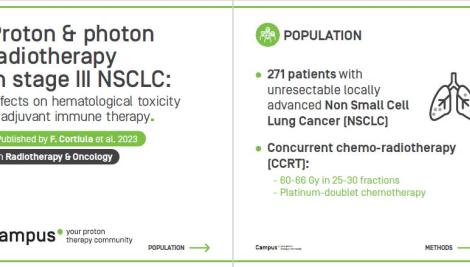Subtitle
High-Risk Non-Small Cell Lung Cancer Treated With Active Scanning Proton Beam Radiation Therapy and Immunotherapy.
This study reported results of PBS-PT (60 GyRBE in 30 fractions) and immunotherapy for 29 patients with locally advanced (stage IIB to IIIC, 90%) high-risk NSCLC which was defined as severe underlying cardiopulmonary dysfunction, history of prior thoracic radiation therapy, and/or large volume or unfavorable location of disease (e.g. bilateral hilar involvement, supraclavicular involvement). Patients who demonstrated excess respiratory motion (i.e. greater than 1 cm in any dimension noted on the 4DCT simulation scan) were deemed to be ineligible for PBT. No patients developed grade 4 or higher toxicity. A total of 6 acute grade 3 toxicities were observed including esophagitis (n = 4, 14%), dyspnea (n = 1, 3.5%), and cough (n = 1, 3.5%). A total of 7 grade 3+ late toxicities were observed in 5 patients including pneumonitis (n = 2), pleural effusion (n = 2), lung infection (n = 1), dyspnea (n = 1), and esophageal stricture (n = 1). The majority of patients went on to receive immunotherapy, and high-grade pneumonitis was rare. Two-year progression-free and overall survival was estimated to be 51% and 67%, respectively. The authors remarked that close monitoring of tumor changes was required as 28% of cases required a PBT replan during treatment. Radical PBT treatment delivered in curative fashion in a cohort of patients with high-risk lung cancer appears to be feasible with careful multidisciplinary evaluation with rigorous follow-up.


